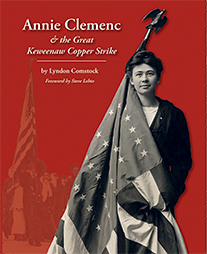|
This current year marks the 100th anniversary of a contentious time in American labor history—the bitter strike of miners in Michigan’s Copper Country—and its grim climax, the infamous Italian Hall disaster on Christmas Eve in the city of Calumet.
Those only vaguely familiar with this history might still recognize the name of legendary “Big Annie”—that is, Anna Clemenc, the Slovenian-American and socialist Joan-of-Arc heroine of these events who ultimately received several honors from her home state.
However, while this woman’s whereabouts during the pivotal last half of 1913 have been well documented and much discussed, it’s the mysteriously missing ‘rest of her life’—far too long mired in obscurity—which has tenaciously tantalized researchers like myself.
So when fellow author and Copper Country historian Steve Lehto (who has gained my utmost respect through his own body of work) recently expressed especial enthusiasm for a new and expanded look at this elusive individual, I bubbled with anticipation.
Sure enough, the century-old prediction of an Annie acquaintance, Ella Reeve “Mother” Bloor, of its taking “a whole book to tell the story of this young pioneer” comes true through the yeoman efforts of former Michigander Lyndon Comstock in Annie Clemenc and the Great Keweenaw Copper Strike, his first published work. Uniquely underscored by the perspectives of this former activist himself, it’s a fine interpretation of some outstanding research that thankfully lacks any unnecessary embellishments or overbearing language—a product that’s “humbly transparent” in allowing the subject to largely speak for itself, and therefore carries bravely the high quality of Steve Lehto’s aforementioned groundwork—which is likely the highest compliment I can pay a product as such.
This reader was immediately treated to a crisp introduction by Mr. Lehto (quite fittingly, in view of my earlier remarks) that was followed early on by a big surprise with a very personal twist: as revealed by the author, a very young Annie had apparently spent some extended time in her ancestral Balkan homeland near Crnomelj, Slovenia, located in the far southeastern corner of that country and cradled by the Kolpa River that marks the Croatian border—a rather weird and unusual “reverse migration” of sorts that preceded a permanent return to the States.
Crnomelj is (as it was then) part of a birch & vineyard-infested region historically known as the Duchy of Carniola (when it was part of the Austrian-Hungarian empire), White Carniola or Bela Krajina (“White March”), and has long been a real “Bohunk” mixture of ethnic Slovenians, Gottscheers (transplanted Germans dating back to the 1300s) and a Croatian minority. And even Ripley himself may not believe that from this relatively remote, confined countryside came forth in the late 1800s the forebearers of not only Big Annie, but also those of two very prominent “Yooper” families (the Ruppes and the Vertins) and—certainly last but not least—those paternally aligned to this reviewer, yours truly!
There are certainly plenty of other fascinating details to this great story that are offered up by Mr. Comstock and that will enlighten (and sometimes confound) the reader—right up to the 1956 passing of Annie Clemenc (by then citizen of Chicago and thrice unhappily wed)—but I won’t spill any more of them here and risk spoiling for others the same sort of fuzzy-warm anticipation I eventually found fulfilled, with a satisfaction competently supplemented by a solid list of trusted sources and some pertinent documentation. The book seems to lack only an index, but I wouldn’t at all be surprised to see one come along in due time based on my personal exchanges with (and as a result, utmost confidence in) this easygoing, open-minded, California-based author.
In the end, I found myself asking “So what, then, about the ‘S’ word,” meaning socialism, which had gained major-league momentum during Big Annie’s Prime Time but was left languishing in “survival mode,” soon thereafter?
Seeking a more contemporary (and larger) perspective, I recently looked beyond the realm of Big Annie for clues. In the Salvador Allende Reader, James D. Cockroft notes the undeniable, utter failures of neoliberalism across the globe, the unchecked power of multinational corporations, unsustainable consumer economies, and the relative successes of concurrent “social democratic” movements, in comparison.
Perhaps the real lesson of Big Annie, then, as we note the 100th anniversary of her fame, the 50th anniversary of the murder of JFK (a Social Democrat himself, in practice), and the 40th anniversary of the brutal demise of Mr. Allende, is that the time is certainly ripe for ‘ordinary’ Americans to begin a serious effort to regain control of their own collective destiny, and the government that is theirs by decree.
Gerry Mantel
Pittsburgh, PA
August 2013
Slovenska Narodna Podporna Jednota (SNPJ), the Slovene National Benefit Society founded in 1904 to serve immigrant workers and their families, continues into the 21st century. Here's our PHOTOGALLERY for a July 2013 visit to SLOVENEFEST, the organization's annual celebration of Slovenian American cultural heritage.
| 
